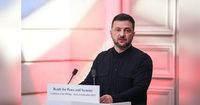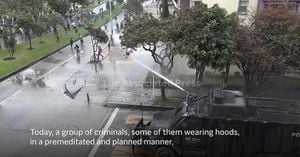In a week marked by diplomatic maneuvering and tense negotiations, Ukrainian President Volodymyr Zelenskyy arrived in Washington on October 17, 2025, to make a direct appeal to U.S. President Donald Trump: supply Ukraine with Tomahawk missiles, the long-range weapons Kyiv believes could shift the balance in its grinding war against Russia. The request, delivered during a face-to-face meeting at the White House, came amid a flurry of high-level talks, shifting alliances, and renewed questions about the United States' commitment to Ukraine's defense.
The stakes could hardly be higher. Russia, having launched its full-scale invasion of Ukraine more than three years ago, now controls nearly 20% of Ukrainian territory, including Crimea, which was annexed in 2014. This year alone, Russian forces have seized an additional 5,000 square kilometers—about 1% of Ukraine’s land—according to statements by Russian President Vladimir Putin earlier this month, as reported by Reuters. The war has intensified, with both sides escalating attacks on each other’s energy infrastructure and Russian drones straying into NATO airspace.
For Zelenskyy, the Tomahawk missiles represent more than just firepower. "Tomahawk missiles are key to bringing Russia to peace negotiations," he told Trump during their meeting, as reported by multiple outlets including NPR and Deutsche Welle. These American-made cruise missiles, capable of striking targets up to 1,500 miles away, would give Ukraine the ability to hit deep behind Russian lines, potentially disrupting logistics and the military-industrial complex that fuels Moscow’s war machine.
Oleksandr Kraiev of the Ukrainian Prism Foreign Policy Council explained Ukraine’s logic to NPR: "Everything that is long-range, everything that is precise, everything that can destroy not only Russian logistics, but also Russian industry, especially Russian fuel industry, is something that is able to stop Russian advances." Since August, Ukrainian forces have struck Russian oil industry targets at least 58 times, according to a joint analysis by Reuters and the UK’s Open Source Center. These attacks have strained Russia’s fuel supply and, Ukrainian officials claim, slowed Russia’s momentum on the front lines—allowing Ukraine to reclaim some territory.
Yet for all the urgency in Zelenskyy’s request, the U.S. response has been anything but straightforward. President Trump has sent mixed signals, oscillating between support for Ukraine’s military needs and caution about depleting America’s own arsenal. After a lengthy phone call with Putin on October 16, Trump told reporters, "We need Tomahawks, also. We don’t want to be giving away things that we need to protect our country." The Associated Press and NPR both noted that Trump’s tone became more conciliatory after speaking with the Russian leader, raising doubts about the likelihood of immediate U.S. military assistance to Ukraine.
Putin, for his part, has made his opposition clear. Kremlin aide Yuri Ushakov warned that transferring Tomahawks to Ukraine "would cause substantial damage" to U.S.–Russian ties and harm the peace process. Trump himself, in a moment of candor with reporters, joked: "What do you think he’s going to say, 'Please sell Tomahawks?' No, he doesn’t want Tomahawks given to Ukraine." He called the missiles a "vicious weapon"—a pointed reminder of their destructive potential and the geopolitical risks involved.
The diplomatic calculus became even more complicated when Trump announced plans to meet Putin in Budapest for face-to-face talks aimed at ending the conflict. The summit, expected to take place within weeks, has been welcomed by some in Europe as a potential path to peace, but has also sparked anxiety in Kyiv and among Ukraine’s supporters. Hungarian Foreign Minister Peter Szijjarto confirmed Budapest’s readiness to host the meeting, promising "full security" for the talks. Notably, Hungary withdrew from the International Criminal Court earlier this year, after the court issued an arrest warrant for Israeli Prime Minister Benjamin Netanyahu—a move that now allows Putin, himself under ICC indictment, to travel there without fear of arrest.
For Zelenskyy, the timing of Trump’s outreach to Putin could hardly be more troubling. Ukrainian officials and analysts see the Kremlin’s willingness to resume dialogue as a potential stalling tactic, designed to delay or derail the transfer of Tomahawks and other advanced weaponry. Max Bergmann, a Russia expert at the Center for Strategic and International Studies, told Newsweek, "It does seem that Putin's outreach is perhaps designed to thwart the potential transfer of Tomahawks to Ukraine, so Putin is wanting to put that back in the box." Mykola Bielieskov, a senior analyst at Come Back Alive, a Ukrainian NGO, added that while Tomahawks would not be a "silver bullet," they would exert constant pressure on Russia’s military-industrial complex. "It's about pressure, constant pressure. It's about disrupting the military-industrial complex," Bielieskov said.
Despite these headwinds, Zelenskyy has sought to broaden the conversation. On the economic front, he has floated proposals for the U.S. to store liquefied natural gas in Ukraine’s vast underground facilities—an idea aimed at strengthening America’s foothold in Europe’s energy market, according to the Associated Press. In meetings with U.S. Energy Secretary Chris Wright and American executives, Zelenskyy emphasized the need to rebuild Ukraine’s war-damaged energy infrastructure and expand "the presence of American businesses in Ukraine."
Back in Kyiv, public opinion remains wary. Many Ukrainians, NPR reported, are skeptical that Trump will deliver on his promises, recalling past episodes where U.S. support seemed to waver after talks with Putin. Olena Puchilo, a social worker from Mykolaiv, summed up the mood: "We have already gone through this, and we have not seen any tangible results... but there is still room for miracles."
Trump’s own position has shifted over time. As recently as September, he described Russia as a "paper tiger" and suggested Ukraine could reclaim all occupied territory, according to NPR. Former U.S. diplomat Daniel Fried observed that Trump’s growing frustration with Putin—and his recognition of Ukraine’s resilience—may be nudging him toward greater support for Kyiv. Retired Rear Adm. Mark Montgomery, now at the Foundation for the Defense of Democracies, noted that "pushing hard for peace" sometimes means acknowledging Russia as the aggressor and arming Ukraine accordingly.
Even the personal relationship between Trump and Zelenskyy has changed. Earlier in 2025, Trump and Vice President JD Vance had publicly berated the Ukrainian leader. But in recent months, the tone has softened. Zelenskyy has even suggested nominating Trump for the Nobel Peace Prize if he manages to secure a durable ceasefire—a gesture that, while partly symbolic, underscores the stakes and the shifting dynamics at play.
Yet the path to peace remains fraught. Zelenskyy has voiced support for a ceasefire and the start of negotiations, but has stopped short of endorsing Trump’s suggestion that Ukraine and Russia "stop where they are"—a proposal that would leave nearly a fifth of Ukraine under Russian control. As the world watches, the question remains: will diplomacy, backed by credible military deterrence, finally bring an end to Europe’s deadliest conflict in decades?
With so much riding on the outcome of the upcoming Budapest summit and the fate of the Tomahawk missiles, both Kyiv and Moscow are bracing for what could be a pivotal moment in a war that has already reshaped the continent—and tested the resolve of its leaders in ways few could have imagined.






